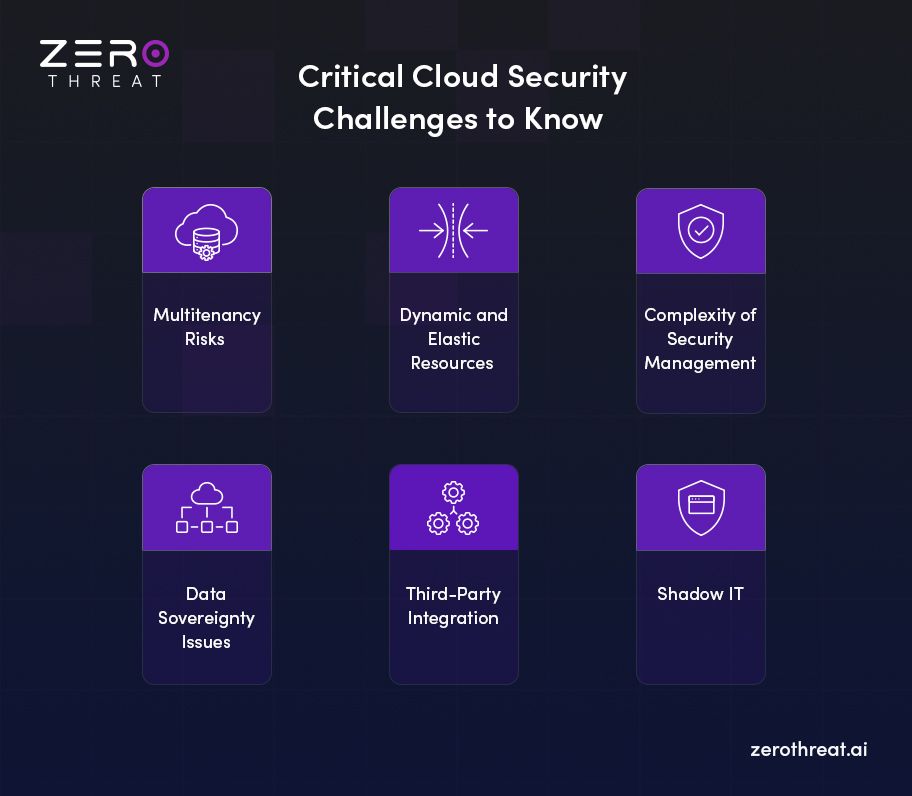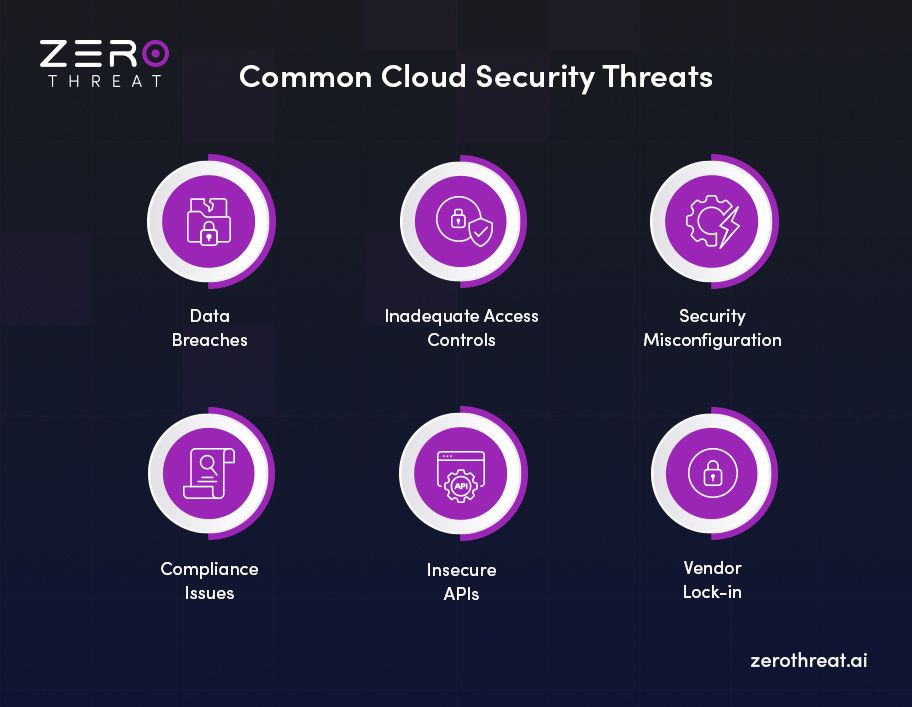All Blogs
Cloud Security Challenges: Addressing Emerging Security Issues, Risks, and Mitigation Practices

Quick Summary: Cloud security must be consistently implemented and monitored to avoid potential issues. Understanding the threats and challenges in the security of the cloud is crucial for enforcing effective defensive measures. This blog explains what cloud security is, its importance, the challenges and threats it entails, and best practices to follow. Keep reading to master hellbent security for your cloud infrastructure.
As the information technology sector is advancing, cloud computing is becoming a prime choice for industry experts. It's because cloud computing solutions offer services like servers, storage, databases, networking, software, analytics, and intelligence, all with ultimate flexibility and scalability in a budget-friendly package.
According to Statista’s report, 83% of organizations plan to shift their workloads to the cloud for increased efficiency and flexibility.
However, there are some major security challenges in cloud computing that compel organizations to reconsider optimizing cloud solutions. These cloud security issues overshadow many significant features of the cloud that traditional infrastructure fails to offer. Therefore, it's crucial to address security issues in cloud computing and fix them permanently.
Hence, we have created this blog to shed light on mostly faced cloud security challenges and have curated staunching security measures for you to resolve the pressing issue of security in the cloud.
Defeat Potential Security Challenges with Our Next-gen Vulnerability Assessment Tool Leverage NOW
Table of Contents
- What is Cloud Security?
- Why is Cloud Security Important?
- 6 Critical Cloud Security Challenges
- 6 Common Cloud Security Threats
- 7 Powerful Cloud Security Best Practices
- Final Statement – Leverage ZeroThreat’s Automation
What is Cloud Security?
Cloud security comprises a diverse range of practices, modern technologies, and policies that are crafted to safeguard applications, data, and services hosted in the cloud environment. Cloud security protects confidential information through measures like proper access controls, encryption, and identity management, which ensures that only legitimate users can access the resources.
Also, cloud security ensures the inclusion of compliance with regulatory requirements, threat detection, response to potential incidents, and strong network security to safeguard data in transmission. With advanced vulnerability assessment and implementation of the best cloud security practices, businesses can maintain the privacy, integrity, and availability of their cloud-based assets and alleviate risks associated with cyber threats.
Why is Cloud Security Important?
By now, you will have gotten a brief idea of cloud security’s role in cloud computing. But here, we have mentioned some of the key cloud security factors that you must read to understand the vitality of security in cloud computing.
1. Data Protection
Organizations store confidential data in the cloud as it ensures the unfailing security of the data and protects it from potential data breaches, unauthorized access, and data theft.
2. Compliance Requirements
Many industries go through strict regulations regarding data confidentiality and security. Ideal cloud security helps businesses ensure compliance with legal requirements and standards, which prevents the risk of penalties.
3. Business Continuity
An effective cloud security system ensures end-to-end protection against data loss and service disruptions. Cloud security also allows businesses to continue seamless operations even in the condition of cyber threats or outages.
4. Cost Efficiency
Investing in cloud security can prevent costly data breaches and incidents, which eventually helps organizations save money in the long run.
5. Threat Mitigation
With sophisticated cyber threats, robust cloud security measures enable businesses to identify and fix threats in the initial stage. Businesses are not only enabled to work on threats in the initial stage but are also saved from the critical consequences that such threats are capable of causing.
6 Critical Cloud Security Challenges You Must Know

Here are the critical challenges that organizations face while deploying cloud-hosted solutions. Give it a thorough read to get a complete idea about emerging cloud security issues and challenges.
1. Multitenancy Risks
In a cloud environment, multiple users share the same physical resources. This multitenancy model can sometimes result in data leakage if isolation measures are not properly performed. This gives attackers a chance to exploit vulnerabilities to access data belonging to other tenants.
2. Dynamic and Elastic Resources
Cloud resources can be swiftly scaled up or down based on demand. This dynamic nature makes it challenging to maintain consistent security policies and controls. Such a dynamic market environment can cause vulnerabilities to be exploited by security threats if updated resources are properly configured.
3. Complexity of Security Management
Organizations often have limited control over the physical infrastructure used by cloud service providers. This can give rise to concerns related to the security practices and policies of third-party providers, which makes it significant to conduct extensive vendor assessments.
4. Data Sovereignty Issues
Data stored in the cloud may be subject to different legal and regulatory requirements depending on where the data is physically located. This can complicate compliance efforts, especially for organizations operating in multiple jurisdictions.
5. Third-Party Integration
Many cloud services rely on third-party applications and integrations. Each integration can introduce new vulnerabilities. This makes it crucial to assess the security of all third-party solutions used within the cloud ecosystem.
6. Shadow IT
Employees may use unauthorized cloud services or applications (shadow IT) to meet their needs by creating security blind spots. This can lead to data being stored in insecure environments outside the organization’s control, which later becomes a major cloud security challenge for the organization to beat.
6 Common Cloud Security Threats

Let’s discover some of the most faced cloud security threats and attacks that notably affect organizations. Check out these security risks of cloud computing to prevent them in the future with robust solutions.
1. Data Breaches
Cloud environments are the favorite targets for cybercriminals as they find ample confidential information for their exploitation. A successful data breach can lead to notable financial losses, legal repercussions, and damage to an organization’s goodwill. Hence, a strong security solution involves implementing strong encryption, regular audits, and robust incident response plans.
2. Inadequate Access Controls
Innovate identity and access management (IAM) is essential in cloud security. Insufficient controls can enable unauthorized users to obtain access to confidential information or resources. Organizations must perform strong authentication methods, such as multi-factor authentication (MFA), and regularly monitor access permissions to mitigate this risk.
3. Security Misconfiguration
Misconfiguration of cloud services is a common cloud security issue that leads to the exploitation of vulnerabilities. An ideal example of security misconfiguration could be improper security settings, open ports, or insufficient resource isolation. Uniform configuration audits and automated tools can help recognize and fix misconfigurations before their exploitation.
4. Compliance and Regulatory Requirement Issues
Organizations must navigate complex regulatory requirements related to data privacy and security, such as GDPR, HIPAA, and PCI DSS. Ensuring compliance is a common security issue in cloud computing, especially with data stored across different jurisdictions. Developing a clear compliance plan and leveraging compliance tools can help mitigate this challenge.
5. Insecure APIs
APIs are pretty important for connecting different cloud services, but they can also introduce vulnerabilities. Insecure APIs can be exploited to gain unauthorized access to data or services. Organizations should perform secure coding practices, regular API security testing, and ensure API gateway security to prevent potential threats.
6. Vendor Lock-in
Businesses frequently face challenges when attempting to migrate data and applications between different cloud providers, which leads to vendor lock-in. This can complicate security management and limit flexibility. To avoid this risk, organizations should design cloud architectures that are portable and consider multi-cloud strategies.
Safeguard Your APIs with an Advanced API Testing Tool Perform Testing for FREE
7 Powerful Cloud Security Best Practices
Enforcing robust cloud security practices is indispensable for safeguarding sensitive data and maintaining compliance. Here are some powerful cloud security best practices to consider.
1. Data Encryption
Encrypting data both at rest and in transit is crucial. This means that sensitive information stored in cloud databases and during transmission over networks should be protected using strong encryption algorithms. This helps to prevent unauthorized access by ensuring that even if data is intercepted, it remains unreadable without the decryption key.
2. Regular Security Assessments
Conducting regular security assessments, such as vulnerability scanning and penetration testing, helps recognize and alleviate potential vulnerabilities in cloud environments. Vulnerability scans automatically detect weaknesses, while penetration tests replicate real-world attacks to evaluate the effectiveness of security measures. These assessments should be part of an ongoing strategy to maintain a robust security posture.
3. Data Backup and Recovery
Establishing a robust data backup and recovery strategy is crucial. Regularly scheduled automated backups of critical data ensure that information can be restored in case of data loss or breaches. A well-defined disaster recovery plan should outline the steps to take in the event of a security incident, including roles, responsibilities, and communication strategies.
4. Network Security
Deploying firewalls and security groups helps control traffic to and from cloud resources, minimizing exposure to potential threats. Enforcing a virtual private network (VPN) allows for secure remote access to cloud services by making sure that data transmitted over the network remains protected.
5. Third-party Risk Management
Evaluating the security posture of third-party vendors is pretty important, as these relationships can introduce vulnerabilities. Organizations should perform extensive assessments and include security requirements in contracts with service providers to ensure they meet the necessary security standards.
6. Compliance and Regulatory Requirements
Understanding and adhering to industry-specific regulations, such as GDPR or HIPAA, is critical for cloud security. Regular audits should be conducted to ensure compliance with these regulations and internal security policies, helping to avoid legal penalties and reputational damage.
7. Security Automation
Utilizing automation tools for security tasks such as patch management, configuration monitoring, and compliance reporting helps reduce human error and improves efficiency. Automating these processes allows security teams to focus on more strategic initiatives and ensure that fundamental security practices are consistently applied at the same time.
Optimize Automated DAST Tool to Fasttrack Testing without Compromising Excellence Try Modern DAST Tool
Ensure Cloud Security with a Well-Defined Strategy
Achieving cloud security is not a once-and-for-all task; it’s a continuous process that involves monitoring current security measures and updating the latest security solutions to be able to overcome potential cloud security challenges and fix issues. Reading this blog helped you uncover the notable cloud security challenges and threats that are commonly faced and encountered by organizations. But your queries and questions are resolved now as you have read this insightful piece about cloud security.
But there’s more!
Our automated next-gen AI tool ZeroThreat is created to fix major security issues you face by helping you conduct potential web app security testing. This tool allows you to perform complex testing procedures within minutes, as it’s 10X faster than other tools. Not just that, it helps with accurate results and remediation tips for encountered security flaws in your system, all for free. So, Sign Up now and optimize its expertise.
Frequently Asked Questions
What are the types of cloud security methods?
Here are some of the effective types of cloud security methods:
- Data Encryption
- Network Security
- Regular Audits and Monitoring
- Backup and Disaster Recovery
- Third-party Risk Management
- Role-Based Access Control (RBAC)
What is cloud security strategy?
What is cloud security standard?
Explore ZeroThreat
Automate security testing, save time, and avoid the pitfalls of manual work with ZeroThreat.


